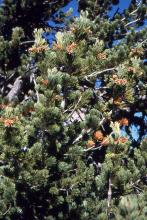Pinus albicaulis
Common name:
Whitebark Pine
Scrub Pine
White Pine
Pronunciation:
PI-nus al-bi-KAW-lis
Family:
Pinaceae
Genus:
Type:
Conifer
Native to (or naturalized in) Oregon:
Yes
- Conifer, evergreen, small to medium, 20 to 50 ft (6-15 m) high and more (the record tree is 69 ft tall), irregular and sprawling crown, short, twisted trunk. Bark thin, whitish, smooth, sometimes scaly on older trunks. Needles are in bundles of 5, short, 4-7 cm long, more or less curved, dark yellow-green, crowed at the end of twigs, sweet smelling and tasting. Female cones 4-8 cm long, mostly at the top of upswept branches, egg-shaped or rounded, almost stalkless, purple to brown, shedding at maturity but not opening, seeds escape only when cones decay. However, a bird, the Clark's nutcracker, tear open attached cones with their strong beaks to extract the seeds, and this activity along with and their seed-cashing habit, likely assists in regenerating Whitebark Pine.
- In October 2005 I visited Crater Lake National Park in southern Oregon and photographed this species. The cones were not the usual shape as described above, rather they appeared abnormal in that they had more or less flared ends and the bracts well separated. These "abnormal" cones, still attached to the trees, are apparently the result of the Clark's nutcracker harvesting the seed. Other birds and mammals also collect seeds from the Whitebark cones after the Clark's nutcracker has opened up the normally closed cones, this activity may further alter cone structure.
- Sun
- Hardy to USDA Zone 3 Native to central British Columbia, east to southwest Alberta and south to western Wyoming, and east to Washington and Oregon (can be found at Government Camp and near Cloud Cap on Mount Hood and at Crater Lake) and central California. It is common on ridges and near timberline, the trees are exposed to strong, desiccating winds. The numbers of Whitebark Pine trees in subalpine communities is rapidly declining due to white pine blister rust, mountain pine beetle and fire suppression, the later allows shade tolerant species to be more competitive.
- Can you identify these more common Oregon native 2-, 3-, and 5-needle pines?
Photo credit: (EJ) Ed Jensen, College of Forestry





